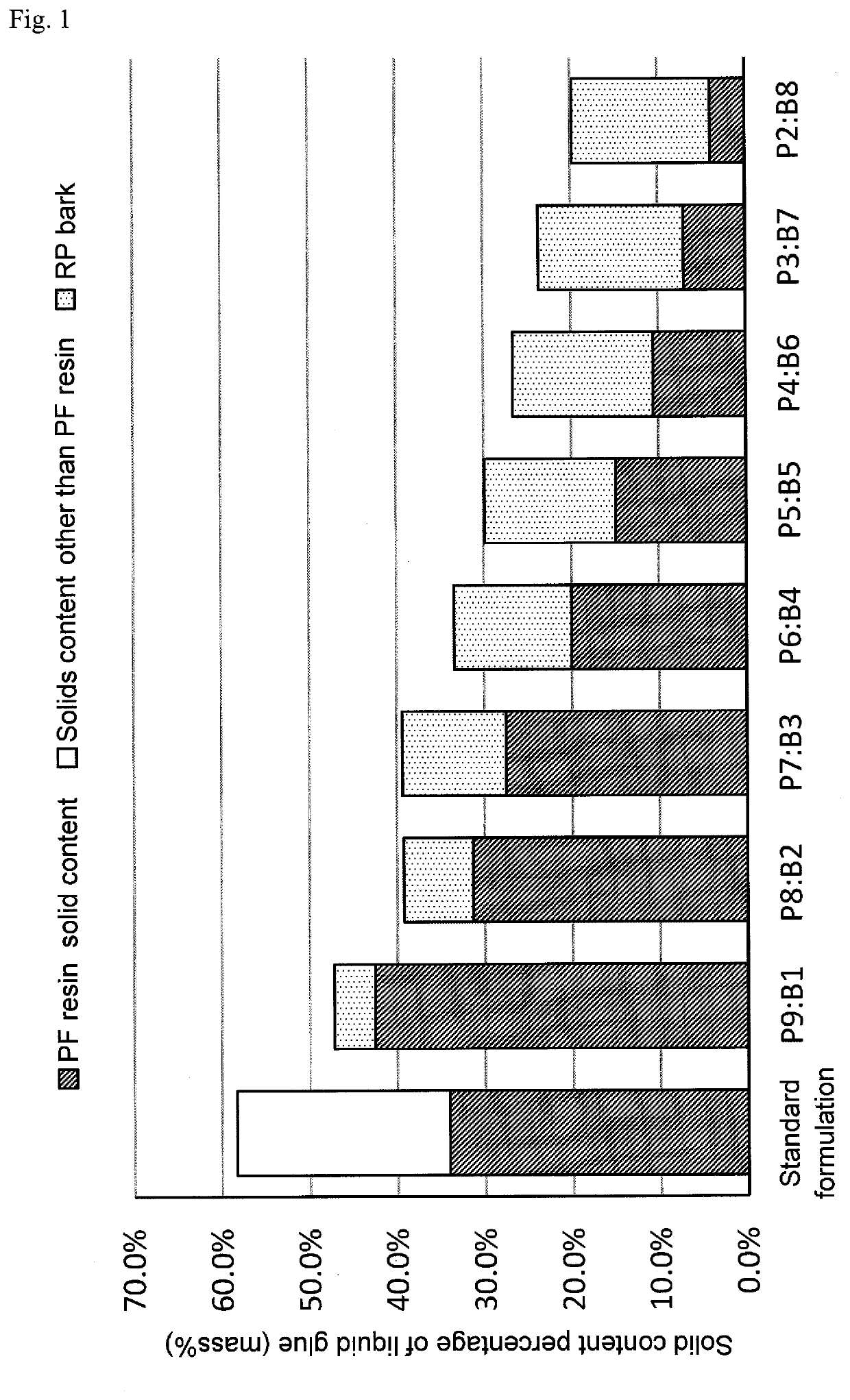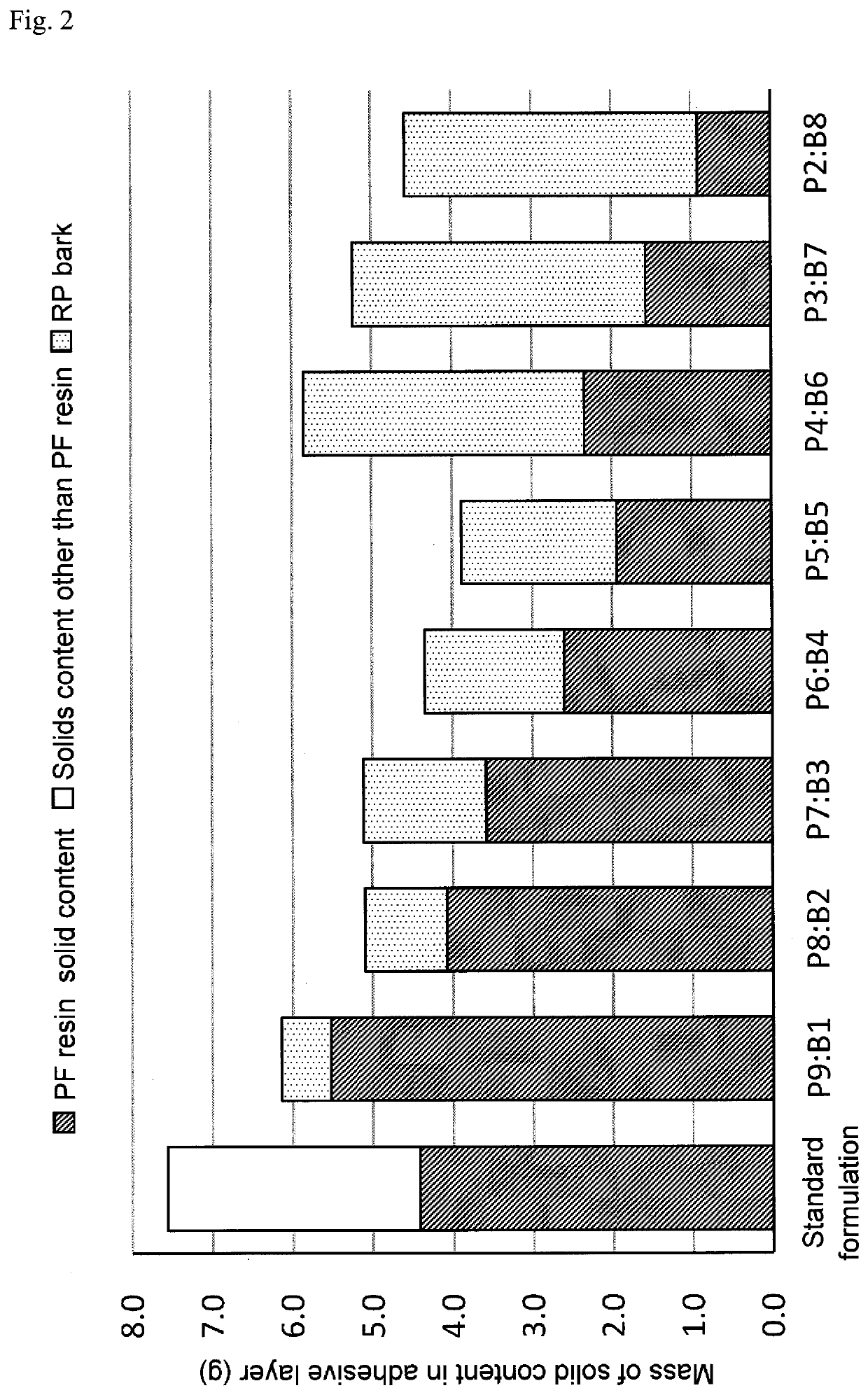Adhesive
a technology of adhesives and bark, applied in the field of adhesives, to achieve the effect of superior adhesion performance and effective utilization of bark
- Summary
- Abstract
- Description
- Claims
- Application Information
AI Technical Summary
Benefits of technology
Problems solved by technology
Method used
Image
Examples
production example 1
[0110]Production of Finely Pulverized Bark
[0111](Step i): Dried radiata pine bark was roughly ground with a garden shredder and then pulverized with a hammer mill equipped with a 1 mm opening screen (metallic mesh).
[0112](Step ii): The pulverized bark obtained in Step i was classified using a 63 μm sieve into diameter of less than 63 μm.
[0113](Step iii): 1 kg of bark having a diameter of less than 63 μm obtained in Step ii was immersed in 10 L of water overnight at room temperature followed by being finely pulverized using a disk mill (Supermasscolloider MKZA10-15J, Masuko Sangyo Co., Ltd.) to obtain an aqueous suspension of finely pulverized bark. The resulting aqueous suspension of finely pulverized bark was freeze-dried directly to obtain dry finely pulverized bark. The maximum particle size of the finely pulverized bark was 40 μm, the average particle size of the finely pulverized bark was 10.4 μm, and standard deviation of the finely pulverized bark was 4.8 μm. Furthermore, thi...
examples 1 to 5
[0115]Adhesives were obtained by mixing a phenolic resin (trade name: Deernol D-117, Oshika Corp.) with the finely pulverized bark at proportions of the solid contents in the adhesive shown in Table 2 followed by adjusting the viscosity with water to the values shown in Table 2.
[0116]The prepared adhesives were spread onto one surface of a rotary lathe-cut single board made of radiata pine at a spread amount of 200 g / m2, another rotary lathe-cut board made of radiata pine was laminated onto the adhesive-spread surface, still another rotary lathe-cut single board made of radiata pine with adhesives of a spread amount of 200 g / m2 on one surface was laminated onto one surface of said laminated boards of two layers resulting in laminated boards of three layers and the resulting laminates were subjected to cold pressing for 30 minutes at room temperature and 1 MPa followed by being closed-assembled for 120 minutes and being subjected to hot pressing for 10 minutes at 135° C. and 1 MPa to...
examples 6 to 8
[0118]Adhesives were obtained so as to have the compositions shown in Table 2.
[0119]The obtained adhesives were spread onto one surface of a rotary lathe-cut boards made of radiata pine at a spread amount of 180 g / m2, also spread adhesive onto another rotary lathe-cut board made of radiata pine at a spread amount of 180 g / m2, and then laminating the two boards by joining the adhesive-spread surfaces thereof to obtain laminates. The obtained adhesives were spread onto one surface of still another rotary lathe-cut single board made of radiata pine at a spread amount of 180 g / m2 and the obtained adhesives were spread onto one surface of the laminated boards of two layers at a spread amount of 180 g / m2 and then laminating the two boards by joining the adhesive-spread surfaces thereof to obtain laminates of three layers. Test specimen of laminates of three layers was obtained in the same manner of Example 1 except above procedure. Test pieces were cut off from the test specimen and then ...
PUM
| Property | Measurement | Unit |
|---|---|---|
| Percent by mass | aaaaa | aaaaa |
| Percent by mass | aaaaa | aaaaa |
| Percent by mass | aaaaa | aaaaa |
Abstract
Description
Claims
Application Information
 Login to View More
Login to View More - R&D
- Intellectual Property
- Life Sciences
- Materials
- Tech Scout
- Unparalleled Data Quality
- Higher Quality Content
- 60% Fewer Hallucinations
Browse by: Latest US Patents, China's latest patents, Technical Efficacy Thesaurus, Application Domain, Technology Topic, Popular Technical Reports.
© 2025 PatSnap. All rights reserved.Legal|Privacy policy|Modern Slavery Act Transparency Statement|Sitemap|About US| Contact US: help@patsnap.com


